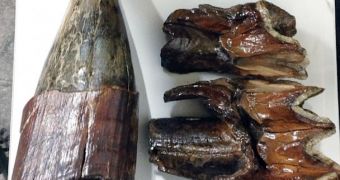The Grand Rapids Public Museum is now in custody of a 10,000-year-old mastodon tooth that it intends to use as an educational tool.
What makes the tooth so special is neither the fact that it is incredibly old, nor the fact that it's almost as big as a loaf of bread. On the contrary, the tooth owes its popularity to the story about how the museum came to own it.
Apparently, the tooth was found inside a donation box for In the Image, a Christian Charity in Grand Rapid, Michigan.
Somebody put it inside this box back in July. John Timmer, one of the charity's employees was the one who found it and later on told the folks at the Grand Rapids Public Museum about his find.
At that time, John Timmer wasn't even aware that what he was holding in his hand was a mastodon tooth, ABC News tells us.
“I picked it up and it looked like a tooth. The root was intact and it was cracked enough so you could see enamel It definitely looked like some sort of tooth. But I didn’t really know what to do with it,” John reportedly told the press.
“And there was a sharper piece that looked like a tusk, possibly, and that one was probably a little bigger, about a foot long and maybe five inches (nearly 13 centimers) wide,” he added.
After one quick glance at the mysterious object, one of the museum's curators concluded that it was a mammoth tooth and broke the news to John Timmer. Needless to say, the latter was a bit taken aback.
“Yeah, it’s a mastodon tooth and it’s probably about 10,000 years old,” the charity employee recalled.
For the time being, neither John Timmer nor the museum's staff has any idea who left the mastodon tooth in the donations box. Given the fact that the tooth is surely worth quite a lot of money, they suspect that whoever left it at the charity's warehouse wasn't even aware of what he was doing.
“We do pickups for donations all the time, mostly at people’s estates if grandfather passed away and the family decides to donate their belongings to us. But I suspect whoever donated it didn’t know it was there,” John Timmer argued.

 14 DAY TRIAL //
14 DAY TRIAL //